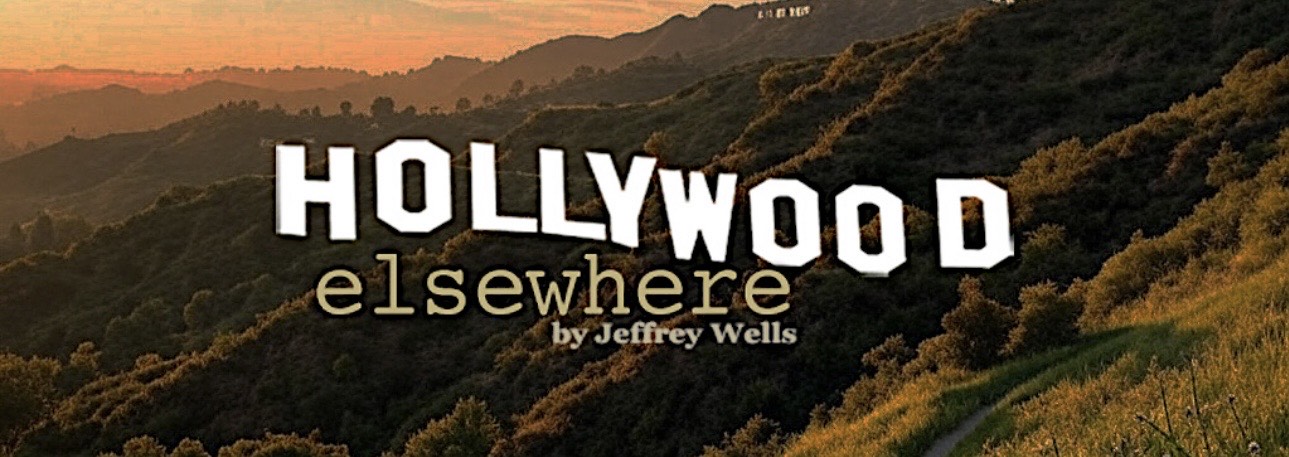Overlooked in last Sunday’s Variety story by Nick Holdsworth about Robert De Niro‘s comments in front of a Karlovy Vary Film Festival audience is a comment he made about wanting to make two more Good Shepherd films. For the tube maybe. Certainly for theatrical. The want-to-see would be close to nil. De Niro is just “talking,” of course, but it gives you an idea of how off-on-their-own-cloud some hyphenates and former movie stars can be.
De Niro said he “would like to make one [sequel] bringing the action forward from 1961 to 1989, the other following its hero, Edward Wilson (Matt Damon), up to the present day,” Holdsworth wrote.
Part One, in other words, would end with the collapse of Communism in the Soviet satellite countries in eastern Europe. It would of course diverge from history in that James Jesus Angleton, the legendary CIA figure whom the Wilson character is largely based upon, died in 1987.
Part Two would presumably concern itself with Saddam Hussein, the ’91 Gulf war, Islamic fundamentalism, the ’93 World Trade Center bombing, 9/11, bogus WMDs, the March ’03 invasion of Iraq and so on.
De Niro said that “although he is not working on research for the concluding parts of the hoped-for trilogy, he said [that] being in central Europe offered a good opportunity to begin thinking about the material. √ɬ¢√¢‚Äö¬¨√Ö‚ÄúI had not been planning to do research on that while here, but it is a good idea,√ɬ¢√¢‚Äö¬¨√Ǭù De Niro said.
Month: July 2008
Che Heading to NYFF?
A 7.9 report by Blogspout’s Karina Longworth about an apparent intention to show Steven Sodebergh‘s Che at the next New York Film Festival was noticed today by Lou Lumenick‘s N.Y. Post blog (along with a half-amusing headline — “Lincoln Center Braces for Che-Mania as Film Fest Books Commie Epic“).
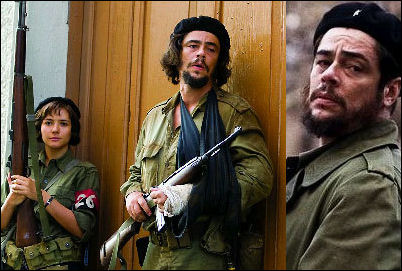
Longworth found her information on the evening of 7.8 while perusing the online version of the July/August issue of Film Comment (like NYFF, a production of the Film Society of Lincoln Center) and on the issue’s index page, there was a preview of the magazine’s September/October issue [which apparently referred to a Che presence at the NYFF]. “For whatever reason,” says Longworth, “if you go to that page today the preview no longer exists, but since it’s still in the Google cache, I was able to screencap it.”
Longworth also links to an announcement from Mumbai’s UTV World Movies channel that Che will be shown on Indian television sometime later this year, apparently in concert with the 50th anniversary of the Cuban revolution, or sometime in December.
Mossberg on 3G iPhone
Here’s the verdict from the Wall Street Journal‘s Walt Mossberg on the 3G iPhone, which comes out tomorrow morning. The two most noteworthy observations are that (a) email and internet surfing is between three and five times faster as it is with the older AT&T network to which the first iPhone was limited”, and (b) in Mossberg’s own testing, the iPhone 3G’s “battery drained much more quickly in a typical day of use than the battery on the original iPhone, due to the higher power demands of 3G networks.”
Six more observations: (c) “Apple’s exclusive carrier in the U.S., AT&T Inc., has effectively negated the iPhone’s up-front price cut by jacking up its monthly fee for unlimited data use by $10, and if you want text messaging, the cost rises further — $5 bucks for 200 monthly messages, or another $120 over the two-year contract”; (d) the main stylistic main difference is the back, which is “now plastic instead of mostly metal and curved instead of flat, and is very slightly thicker in the middle, with tapered edges, and weighs a tiny bit less”; (e) the audio on the new iPhone is greatly improved; (f) the headphone jack now accepts any standard stereo earphones; (g) the camera, however, is still bare-bones with a lousy 2 megapixel resolution; (h) Apple no longer rincludes a dock for charging, just a cable.
Nazi Scalps
New York’s “Vulture” page has gotten a copy and reviewed it. Ain’t It Cool‘s Harry Knowles has also read and semi-reviewed. An intern working for a mid-sized distributor wrote yesterday and told me he has a copy. A guy who works at John and Pete’s liquor store on La Cienega was reading a copy last night between customers. My mother called me last night from Connecticut with her reactions.
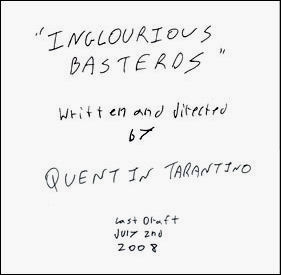
I’m apparently the only movie hound in the civilized world who hasn’t read Quentin Tarantino‘s 165-page script of Inglourious Basterds, which, according to a cover-page photo provided by the Vulture guys, is how Quentin spells it.
They’re reporting, in fact, that the misspelling of bastards “continues through the screenplay,” which suggests that QT “was writing really, really fast.” They’re being cute — I tend to be blunt. Isn’t “basterds” the spelling equivalent of “rite” (as in write), “resterrant” (as in restaurant) and “simputhetik” (as in sympathetic)?
One of three possibilities: (a) Tarantino is a borderline illiterate, (b) He’s having everyone off by pretending to be a retard, or perhaps pretending to be one of the retard soldiers in the piece, or (c) the Vulture guys are having us off. My money is on (a) but you never know.
The script is “definitely the ur-text of Quentin Tarantino’s career up to now,” Vulture proclaims. “It combines his love of old movies (war movies, Westerns, and even prewar German cinema), his attraction to powerful female protagonists, his love of chatter, and his willingness to embrace the extreme — visually and in his storytelling. (The flashbacks have particularly Tarantino-esque flourishes; a thought bubble pops out of a character’s head to introduce one while another is shot spaghetti-Western style.)
“All in all, it reads like Kill Bill meets The Dirty Dozen meets Cinema Paradiso.”
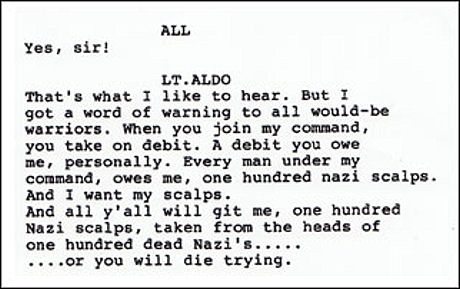
McWeeny, on the other hand, says it’s “The Guns of Navarone meets Malena meets Cinema Paradiso along with a ton of just stuff we don’t have references for. It does celebrate the possibilities within a cinematic universe and in many ways — it’s not a gigantic movie in anyway other than ambition.
“Much of the film takes place in Nazi-occupied Paris — and I couldn’t help it as I read the script, but to imagine actors like Gregory Peck, Ingrid Bergman, Paul Henreid, etc in these roles as opposed to a modern cast. That said and God willing, some brilliant studio will see that this isn’t a recreation of history, slavishly playing to graven memory of war, but a film. A work of pure imagination unleashed upon the cinematic setting of World War II.”
It’s presumed that Brad Pitt‘s character, if and when he signs to star in Basterds, will play a Tennesse redneck with a neck scar called Lieutenant Aldo Raine — obviously an allusion to ’50s B movie star Aldo Ray and his performances in Eisenhower-era war films like The Naked and the Dead, Men in War, Three Stripes in the Sun and Battle Cry.
All I know is that three script sources who’ve come through for me in the past have let me down. It hurts. It feels badly. Well, maybe later today.
Not A Problem
The AP reported this morning that US Airways will remove in-flight entertainment systems on domestic flights come November to save about $10 million annually in fuel and other costs. Spokesman Phil Gee explained that the 500-pound weight of movie systems (i.e., devices that generate video images for those back-of–the-seat screens) forces planes to use more fuel to get around the country. Presumably other carriers will be following suit.
Forget the 500 pounds and the bland in-flight movies with their Disneyworld editing standards and substitute dialogue. Just make it easier to get AC power for passenger computers, iPhones and iPods, and offer gratis broadband service to business and first-class and paid broadband to coach. Simple.
Third Screen Feed
It rambles, meanders and tap-dances for the sake of tap-dancing. But a smart 7.9 article by the Detroit Metrotimes‘ Ashley Lindstrom does specifically grapple with a big exhibition fear — i.e., that competition from the proverbial third screen (computers, Apple TV, iPhones, iPods) will hurt or kill big-screen venues. The answer, provided by NATO president John Fithian and a USC Digital Media Center report, is that this just isn’t happening.
“It would seem counterintuitive that an attention-deficit generation of instant-gratification addicts still makes up the majority of frequent moviegoers,” Lindstrom writes, “but Fithian recalls a 2007 study by the MPAA (Motion Picture Association of America) which shows that individuals who own or subscribe to five or more technologies (DVR, satellite TV, MP3 players, etc.) actually see about four more movies per year than, er, neo-Luddites.
In short, “the old wisdom that techies are by their very nature antisocial creatures is being challenged. For instance, the University of Southern California Digital Media Center’s 2008 report showed that internet users say they spend more face-to-face time with friends and family than nonusers.
“‘For [young people], this is just one more form of being pervaded by media,’ Fithian says, adding that many theaters are looking into rowdier, text-friendly auditoriums to serve their long-term welfare by meeting their youthful patrons’ desires– AMC’s Star Theatre in Southfield, anyone? — and additionally creating adult spaces for more challenging content. AMC offers its ‘AMC Select’ for, they tell us, ‘special films for select tastes,’ most of which are released regionally and occasionally screen in a Detroit-area AMC theater.
The result, says Fithian, is that theatres “are finally back on track after the 2005 slump, and that this year’s take — as of 6.13.08 — is only slightly under last year’s — the year of ‘threequels,’ Fithian interjects — and he fully expects to make up the difference in no time.
Fithian further points out that “the total number of U.S. screens actually increased in 2008, though the sum of theater locations has decreased, which he ascribes to older facilities being torn down and the erection of more modern multi-screened structures.”
Wait…”rowder, text-friendly auditoriums”? As in darkened auditoriums where you’re supposed to watch movies? Include me out.
Up and Down Twice
Arizona Daily Star critic Phil Villarreal on the four career phases of Eddie Murphy — fast track (’80 to ’88), downturn (’89 to ’95), rebound (’96 to ’98) and Murphy’s Law (’98 to ’08).
Birth of the Bat
Holy fruit salad! A recollection by “Reel Geezer” Lorenzo Semple, Jr. about banging out scripts for the old Adam West Batman TV series. “Days of innocence, days of Andalusian heaven!”
Old Stateroom
Where’s the other half of this classic scene? I can’t find it anywhere. This clip only shows a third of it, if that.
Groucho: “Tell me, stew — do they allow tipping on this ship?” Steward: “Yes, sir.” Groucho: “Have you got two fives?” Steward: “Oh, yes sir!” Groucho: “Well, then you won’t need the ten cents I was gonna give ya.”
Wee Hours
Night-before, post-midnight screenings of big summer movies are routine, but I was especially intrigued to hear about 6 am showings of The Dark Knight in this 7.9 N.Y. Times story by Michael Cieply.
One of the most vivid screenings of my life happened when I attended a 5 am showing of THX 1138, which was being shown as part of 24-hour science-fiction marathon. I was barely awake but felt very alive and open-pored. I had seen this George Lucas film at some funky-ass repertory theatre, and at a too-late hour if I correctly recall. I was okay with it after seeing it there. But the 5 am wake-up screening was a revelation in that I came out floored by THX 1138. Every little thing that Lucas intended, I got. Especially the humor.
I’ve been convinced ever since that the very early wee hours (following a few hours of sleep) are the best time to see a movie.
I’m going to keep checking Fandango, but if anyone hears about a 6 am Dark Knight screening in Los Angeles proper, please advise. Why haven’t I seen The Dark Knight in a regular press screening?
Red and White
I mentioned a similarity factor between Rebel Without a Cause‘s James Dean and King of Kings‘ Jeffrey Hunter a few years ago and had forgotten about it, but this 7.8 Burmashave comment reminded me of it: “Anybody ever think about James Dean playing Jesus if he’d lived, and how fucking crazy that would have been?”
King of Kings and Rebel were directed by Nicholas Ray, of course, so in a sartorial fashion Ray did sorta kinda cast Dean in his Bible movie. He did this by having Hunter wear a facismile of the iconic red jacket and white T-shirt get-up that Dean wore in Rebel. Variety critic Todd McCarthy reminded me this morning , in fact, that note that “Ray dressed Hunter in a robe of exactly the same shade of red as Dean’s Rebel jacket.”
The idea of Christ wearing a red robe had already been established in The Robe and Demetrius and the Gladiators, but think for a moment about the ludicrousness of a dirt-poor Jesus of Nazareth wearing a red cloak with a perfect white T-shirt garment underneath. It’s as if they had Gap and Banana Republic shops in old Jerusalem, and Jesus and his disciples occasionally shopped there.
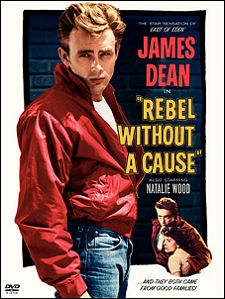
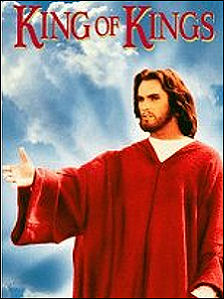
What if J.C. had hired a fashion consultant? “As you know, Nazarene, plain red works fine on every occasion, but — stop me if I’m overstepping — you need to present an extra stylistic distinction, something that says ‘this guy is special’ and not just some, whatever, shepherd or olive farmer or whatever, if you follow my drift. That’s why a white undergarment is such a good idea. And it comes with white briefs in case, perish the thought, you’re ever crucified, because the Roman guards will let you keep the briefs on. Or at least, they have with my other customers.”
“Everything you say about King of Kings is right,” Todd McCarthy wrote about my 7.8 posting, “but to me the most compelling aspect of the film it how political it is. The first whole section of the picture details the political situation in Judea at the time with almost documentary-like attention, and the script’s great and provocative gesture is to present Jesus and Harry Guardino‘s Barabbas as parallel revolutionaries — Jesus of a religious stripe and Barabbas as a political outlaw, which makes the ending ironic.
“In defining the major Jesus films of the ’60s-70s period, it’s fair to say that Stevens’ The Greatest Story Ever Told is the Protestant version, Zeffirelli’s Jesus of Nazareth is the Catholic version, Pasolini’s The Gospel According to St. Matthew is the Marxist version and King of Kings is the Zionist version.
“Of course Hunter is physically far too fair (and note the shaved armpits at the crucifixion), but he still manages to achieve a poignant purity as things move along. The score is one of Rozsa’s very greatest and crucial to covering over various narrative lurches and shortcomings. And, by the way, there are no known 70mm prints, so you can’t blame the Cinematheque for not delivering one.””
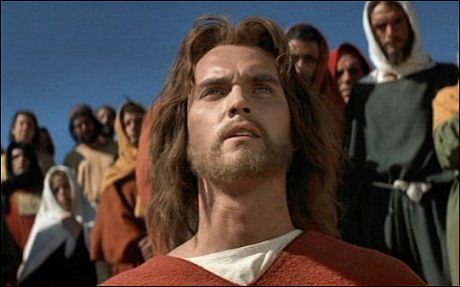
Montana Moment
Nice kids, Access Hollywood scooped…so what?
